1. INTRODUCTION
Some fast-growing tree species have been developed in Indonesia, which includes Acacia spp., Eucalyptus spp., Falcataria moluccana, and Gmelina arborea. Acacia mangium has been identified to be the most adaptable in the marginal area when compared to 46 other species tested by the government (Arisman, 2002). In addition, it easily acclimatizes to various types of soil with varying pH, grows rapidly, and also tends to produce good quality timber (Fujimoto et al., 2002; Kim et al., 2009). Hence, it is widely planted in several tropical countries and subtropics, including Malaysia, Vietnam, Bangladesh, and especially in Indonesia (Fujimoto et al., 2002; Kim et al., 2009), where it is one of the prevalent species developed in the forest of industrial plants, as a raw material for pulp and paper (Marsoem, 2004). Meanwhile, other species (including slow-growing types), encompassing three species of styrac wood, Gmelina arborea, teak, Moluccan ironwood, linggua, red meranti, gofasa and Pinus merkusii, wood properties have been investigated (Iswanto et al., 2016; Hidayati et al., 2017a; Hidayati et al., 2017b; Hidayat et al., 2017; Darmawan et al., 2018).
Therefore, the increasing need for solid wood both in construction and furniture worldwide provides opportunities for fast-growing species to be applied as construction materials and furniture, e.g., A. mangium. This also increases its selling price comparably with being a raw material for pulp and paper. Furthermore, the properties both in density and in strength have been widely studied (Fujimoto et al., 2002; Honjo et al., 2005; Kim et al., 2009; Kojima et al., 2009; Matsumoto et al., 2010; Makino et al., 2012). Nugroho et al. (2011) reported about the wood properties of 5 provenances of A. mangium planted in Indonesia, and Hai et al. (2015) stated evidence about its growth characteristics and wood properties in second-generation progeny test planted in Vietnam. Meanwhile, studies on this property from tree breeding programs material, where their quality is one of the important aspects in obtaining superior products (Zobel and van Buijtenen, 1989) are limited. However, several fast-growing species have been investigated, including A. mangium, Falcataria moluccana, A. auriculiformis, and Eucalyptus (Hai et al., 2015; Ishiguri et al., 2007; Hai et al., 2008; Muneri and Raymond, 2000). Therefore, it is expected that an increase in the quality of A mangium wood is improved through these programs.
Non-destruction and semi-destructive techniques for evaluating wood properties are capable of decreasing cost, energy, and time, and these are applied in solid and non-solid wood products (Jeong et al., 2016; Rofii et al., 2016; Hidayat et al., 2017). Moreover, Pilodyn was introduced as a non-destructive assessment method for density within the breeding program (Sprague, 1983; Woods et al., 1995; Hansen, 2000), as its penetration confers a significantly negative correlation (Taylor, 1981; Wei and Borralho, 1997; Wu et al., 2010; 2011b). In addition, the stress-wave velocity (SWV) method is a non-destructive method for evaluating quality, especially based on mechanical properties (Ishiguri et al., 2007), and a significant, positive association exists with standing trees or log and Young’s modulus of logs (Ross et al., 1997; Wang et al., 2001; Ishiguri et al., 2007; 2013; Wu et al., 2011b).
This study is, therefore, aimed at characterizing variations in growth parameters [stem diameter (D) and tree height (H)], and wood properties [Pilodyn penetration (P) and stress-wave velocity (SWV)] in 65 families of A. mangium, planted in a third-generation progeny trial. Furthermore, the relationships prevailing amongst each were also investigated.
2. MATERIALS and METHODS
The third-generation progeny trial of A. mangium was established in the Forest Research of Alas Ketu, Wonogiri, Central Java province, Indonesia (07°32·S - 110°41·E). This consisted of 65 families, which originated from 8 provenances in Papua New Guinea, and Australia (Table 1), and the set up was established in February 2012. Meanwhile, information on environmental conditions are as follows: the average temperature was 27.22°C, rainfall (1,878 mm/year), the elevation of 141 m above sea level, climate type C (Schmidt and Ferguson), and soil type was vertisol. In addition, the plantation trial was established using randomized complete block design, with six blocks as replications, and four tree-plots for each family, with a spacing of 4 × 2 meters. Furthermore, fertilization was applied two times per year, using NPK up to the point where they were 2-year-old. This process was thinned thrice in the following years: 2015, 2016, and 2017 for retaining one of the best varieties within each tree-plot.
This study involved measuring a total of 278 trees, encompassing the magnitude of growth characteristics (D and H) and wood properties (P and SWV) at 6-year-old. In addition, D was measured at 1.3 m above the ground level, with the aid of a diameter tape (F10-02DM, KDS, Japan), while H was determined using an altimeter (Haga, Germany). Furthermore, P was assessed with a Pilodyn tester (6 J Forest, Proceq, Switzerland) at 1.3 m above ground level, where three replicates were obtained for each tree (Ishiguri et al., 2008; Hidayati et al., 2013a;b), and their barks were not peeled. Meanwhile, within this progeny test site, nine specimens were felled for other studies (anatomical, physical, and mechanical properties), where the mean value of the bark thickness was 5.15 mm (four points of the bark were measured for each tree), and P was, further, assessed. Fig. 1 shows a negative relationship between P and basic density, which is, therefore, a good indicator for predicting the basic density values of A. mangium. Conversely, the SWV of the stem were measured using a commercial hand-held stress wave timer (FAKKOP Microsecond Timer, FAKKOP Enterprise, Hungary), applying the method of Ishiguri et al. (2007), where start sensors set at 150 cm from ground level was hit with a small hammer, in an attempt to create the stress wave, which the stop sensor, placed at 50 cm, receives, and the propagation time between the two was recorded. In addition, eight measurements were obtained, and their mean value was calculated for each tree, therefore, SWV was computed by dividing the value obtained with the distance between (100 cm).
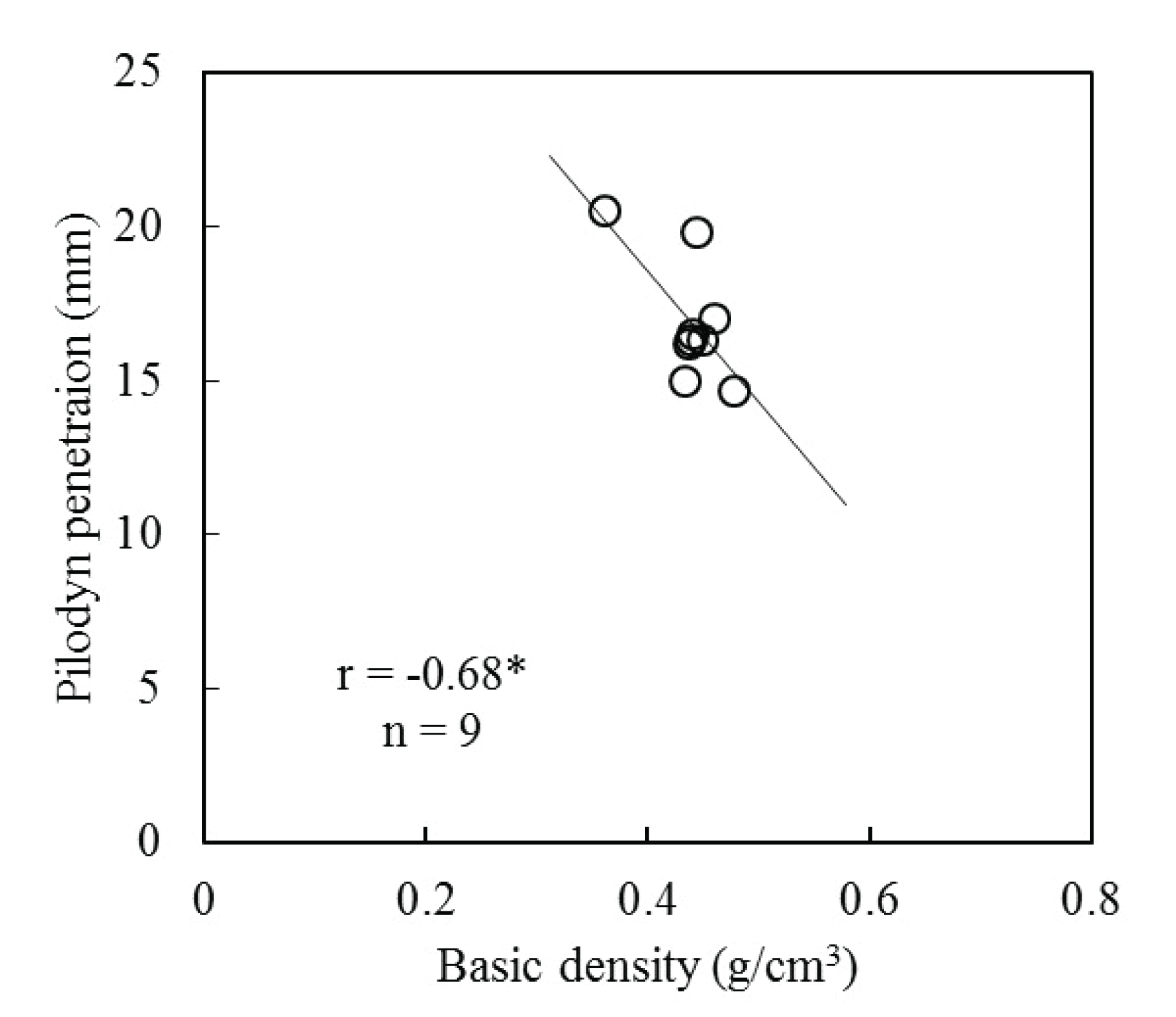
Analyses of variance (ANOVA) were performed to evaluate the differences in D, H, P, and SWV among the tested families, and the following model was used for each character:
where Yij denotes the response of the j-th family in the i-th replication, μ depicts the overall mean, Fj the genetic effect of the j-th family, εij was the error associated with Yij. Furthermore, the narrow-sense family heritability of growth characteristics and wood properties estimated using the following formula, which assesses the magnitude of genetic effects:
where hf2signifies the narrow-sense family heritability, σf2 denotes their variance component, σe2 was the variance component of the error, and R symbolizes block. Moreover, due to the fact that the tested families are half sib, the narrow-sense value obtained was applied in the calculation of heritability.
3. RESULTS and DISCUSSION
Table 2 shows the mean values of stem diameter (D), tree height (H), Pilodyn penetration (P), and stress-wave velocity (SWV) observed at the thirdgeneration progeny trial of A. mangium, where the mean values in each family were 12.7-22.5 cm, 13.7-23.1 m, 15.7-18.9 mm, and 3,238 – 3,627 m/s, respectively.
The results of ANOVA and narrow-sense family heritability are shown in Table 3, and significant differences were observed in all measured characteristics, amongst the 65 families. Hai et al. (2015) reported that D and H showed significant differences between 112 families of 4-year-old A. mangium, planted in Ba Vi, and P were substantially different amid 112 of 4-year-old, 70 families 3-year-old in Tuyen, and 100 families 3-yearold in Bau Bang, Vietnam. Furthermore, it was also reported that dynamic modulus elasticity (MOEd) exhibited a significant difference amongst the 100 families of 3-year-old A. mangium planted in Bau Bang, while Pelletier et al. (2008) stated the D and H of 104-month-old Eucalyptus pilularis planted in Australia to be significantly different amongst 308 families. In addition, D, H, P, and SWV were considerably dissimilar between 19 clones of Eucalyptus hybrid planted in China (Wu et al., 2011a), 21 seed provenances of 24-year-old teak planted in Indonesia (Hidayati et al., 2013a), and also among 15 clones of 12-year-old teak planted and two distinctive sites (Hidayati et al., 2013b). Furthermore, the results obtained were consistent with those in previous studies (Hai et al., 2015; Pelletier et al., 2008; Wu et al., 2011a; Hidayati et al., 2013a,b), hence, it is considered that growth characteristics and wood properties are genetically controlled in A. mangium.
Hai et al. (2015) reported the narrow-sense heritability of D, H, and P to be 0.26, 0.22, and 0.25, respectively for the 4-year-old planted tree in Ba Vi. Meanwhile, in Tuyen Quang, their values including that of MOEd were 0.27, 0.24, 0.21, and 0.15, respectively for the 3-year-old specimen. Furthermore, it was also reported to be 0.14, 0.30, and 0.22, for D, H, and P respectively in 3-year-olds at Bau Bang (Hai et al., 2015). In addition, the values obtained for 104-month-old E. pilularis planted in Australia were 0.20 and 0.27 for D and H, respectively (Pelletier et al., 2008), while broad-sense heritability of D, H, P, and SWV were 0.27, 0.27, 0.23, and 0.24, respectively of 24-year-old teak provenances in Indonesia (Hidayati et al., 2013a). Furthermore, this was also estimated for 12-year-old teak clones, planted at two different sites in Cepu to be 0.50, 0.39, 0.65, and 0.30 respectively for D, H, P, and SWV, while those planted in Ciamis were 0.76, 0.44, 0.60, and 0.27, respectively (Hidayati et al., 2013b). Furthermore, low to moderate values were obtained in the present study (Table 3), indicating a potential for improving growth characteristics and wood properties in A. mangium, through breeding programs. Moreover, the heritability of SWV was observed to be slightly higher than Pilodyn penetration (hi2 = 0.27), suggesting it to be the most important criteria in selecting trees for construction and furniture purpose. Furthermore, the heritability values obtained were higher than what was recorded in prior research (Hai et al., 2015), suggesting its ability to increase with tree age. Meanwhile, it was reported in teak that narrow-sense heritability of D and H gradually increased at an exponent of age (Monteuuis et al., 2011).
Highly positive significant correlations were established between D and H in the present study (Fig. 2), and also for other hardwood species observed in previous research (Kha et al., 2012; Callister and Collins, 2008; Monteuuis et al., 2011; Chaix et al., 2011; Hidayati et al., 2013a, b; Hidayati et al., 2017). This result suggests growth characteristics to be closely related to one another in A. mangium trees.
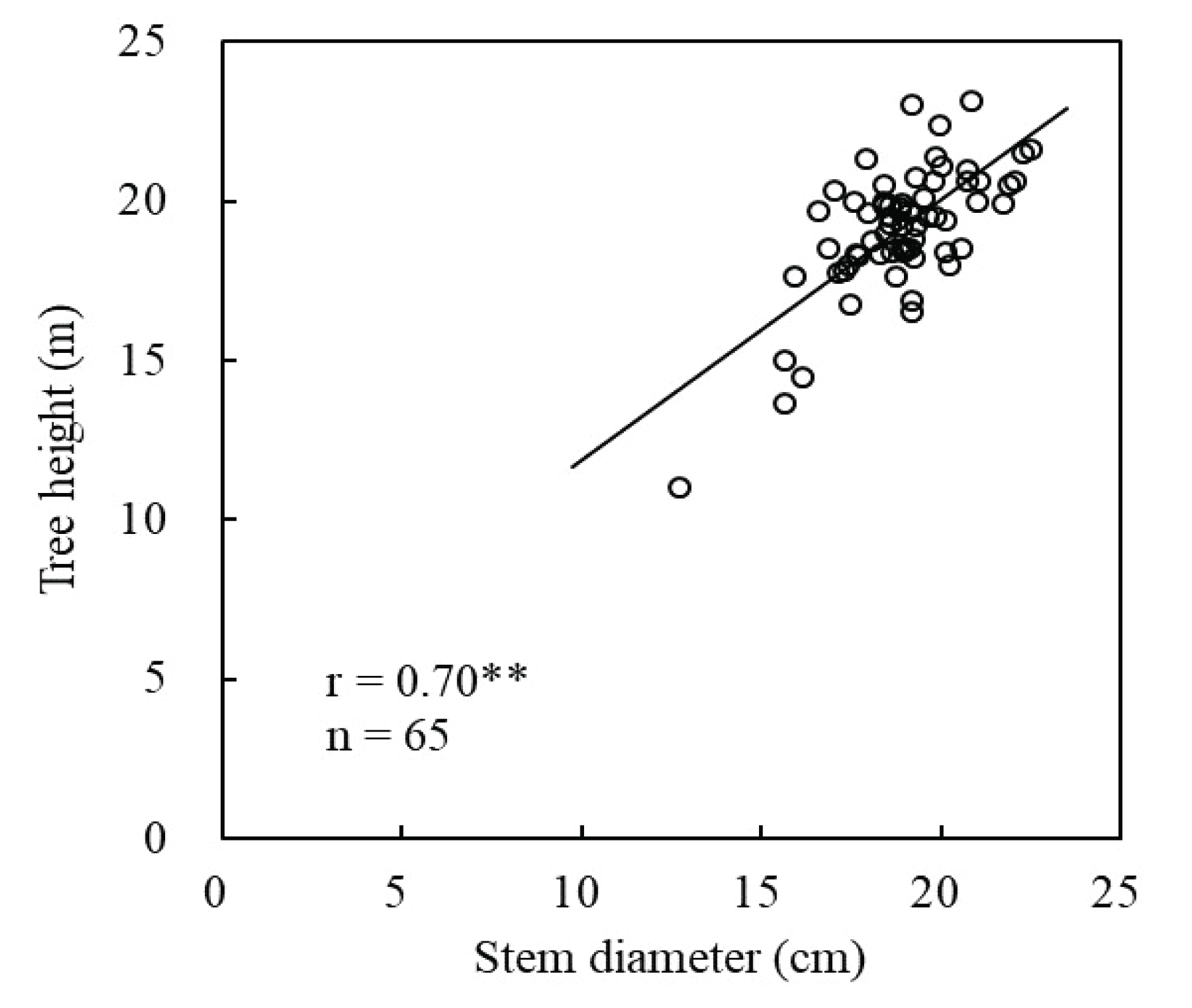
Generally, a substantial negative association was discovered between P and wood density (Moura et al., 1987; Wei and Borralho, 1997; Wu et al., 2010, 2011b). Kojima et al. (2009) reported no correlation concerning xylem density and lateral growth rate in A. mangium planted in Malaysia. In addition, minimal positive correlations were observed amongst growth characteristics (D and H) and P in E. urophylla planted in China (Wei and Boralho, 1997), while moderate to high levels were found in other hardwood species (Wu et al., 2011b; Hidayati et al., 2013a, b), and the present study showed no significant correlations (Fig. 3 & 4). These results are consistent with previous outcomes (Kojima et al., 2009; Wei and Boralho, 1997), suggest that P is independent of growth characteristics in A. mangium.
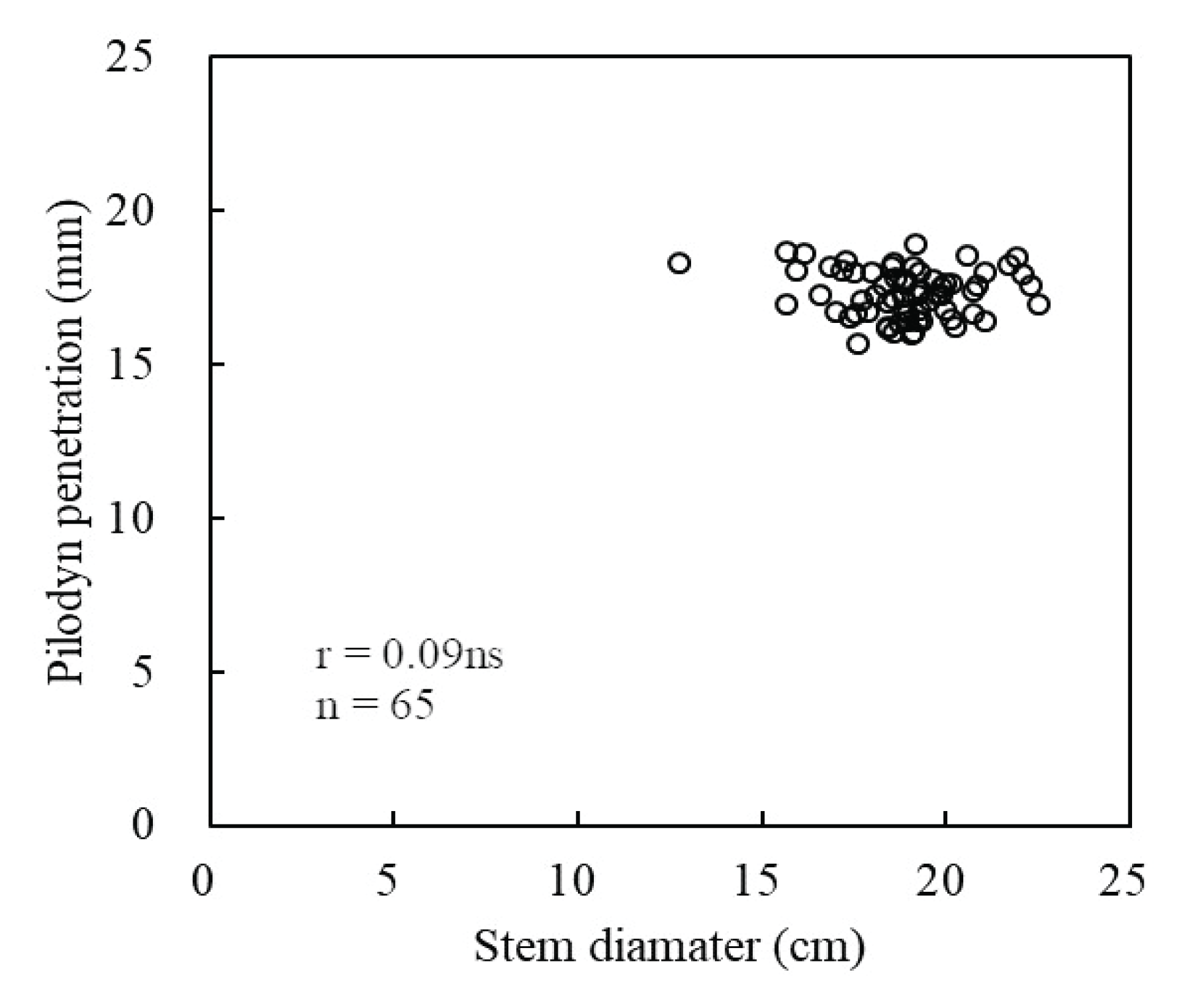
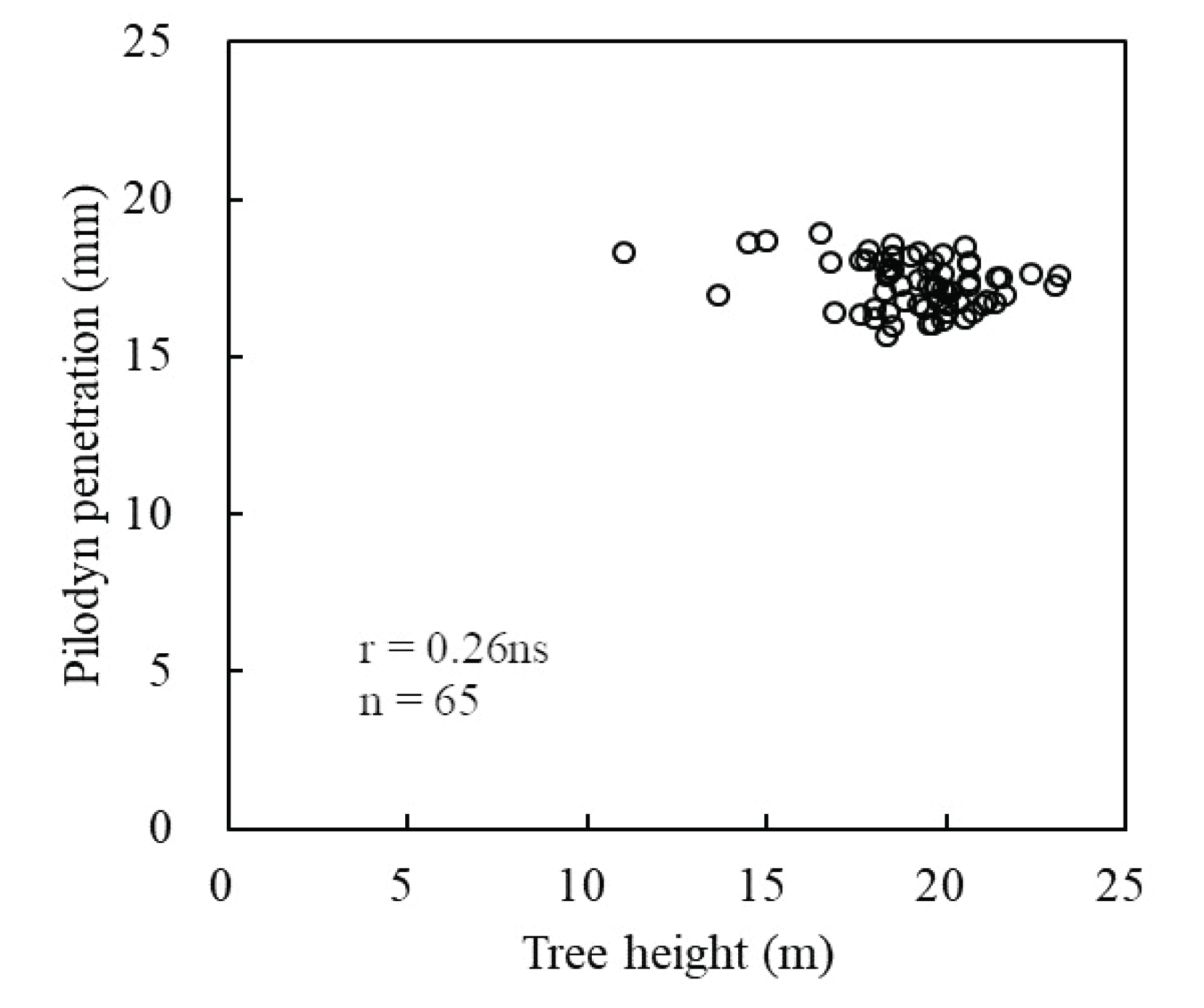
Fig. 5 and 6 illustrate the relationships between growth characteristics and SWV. Stress-wave velocity of standing trees was to be significantly positive correlation to DMOE (dynamic modulus of elasticity) of logs or MOE of small clear specimens (Wang et al., 2001; Ishiguri et al., 2013). Furthermore, D negatively correlates, though slightly, with DMOE (Hai et al., 2015), while Makino et al. (2012) reported no significant correlation to occur in those planted within Indonesia. In addition, other hardwood species showed no sgnificant correlation between growth characteristics (D and H) and SWV, which was also attested by other reports (Dickson et al., 2003; Ishiguri et al., 2011; Hidayati et al., 2013a, b; Hidayati et al., 2017). Moreover, these study outcomes are consistent with previous results (Hai et al., 2015; Makino et al., 2012; Dickson et al., 2003; Ishiguri et al., 2011; Hidayati et al., 2013a, b; Hidayati et al., 2017). Therefore, it can be concluded that physical and mechanical properties are also important characters for the selection criteria within breeding programs, and SWV (which is mechanical) seems to be the most important.
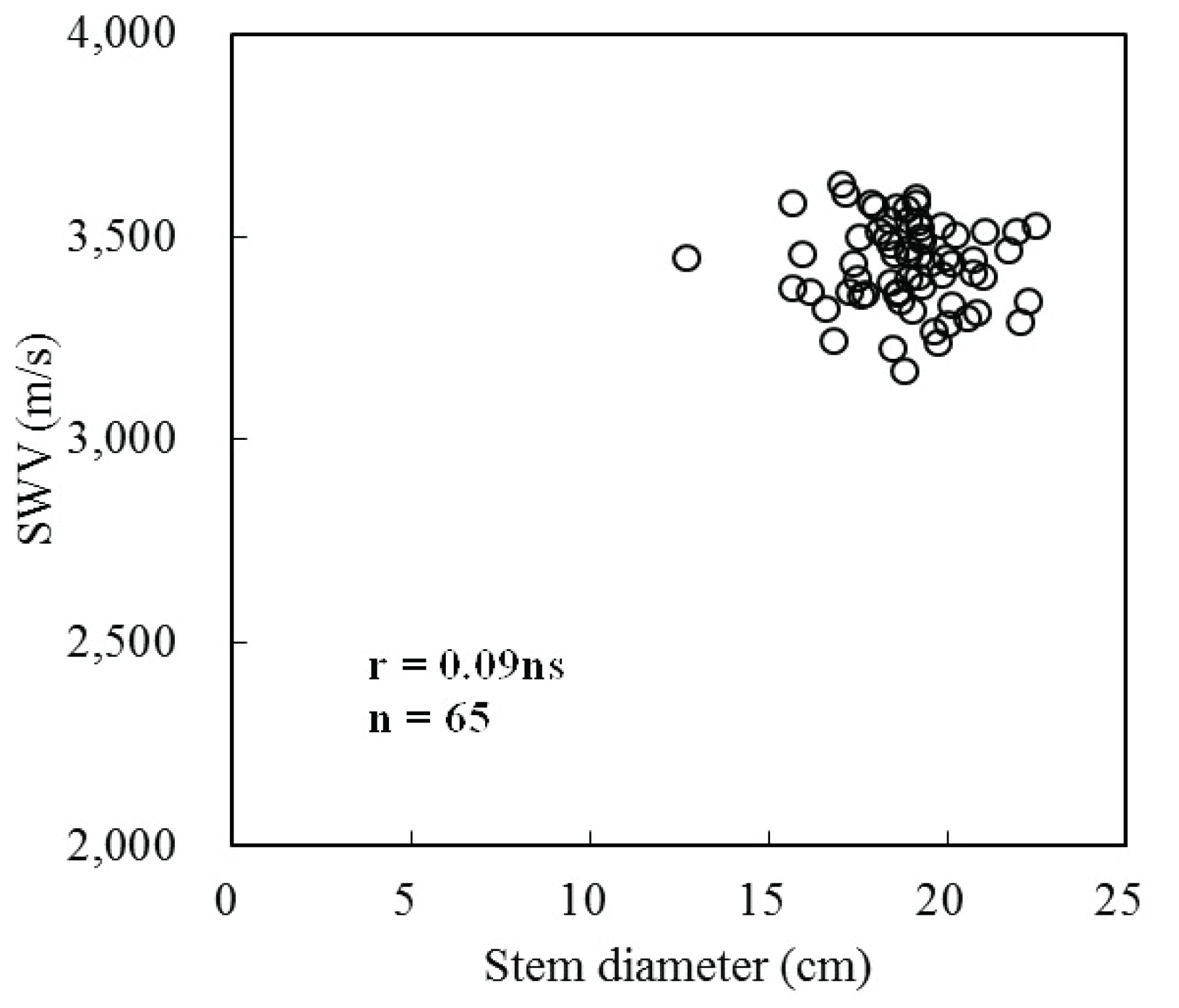
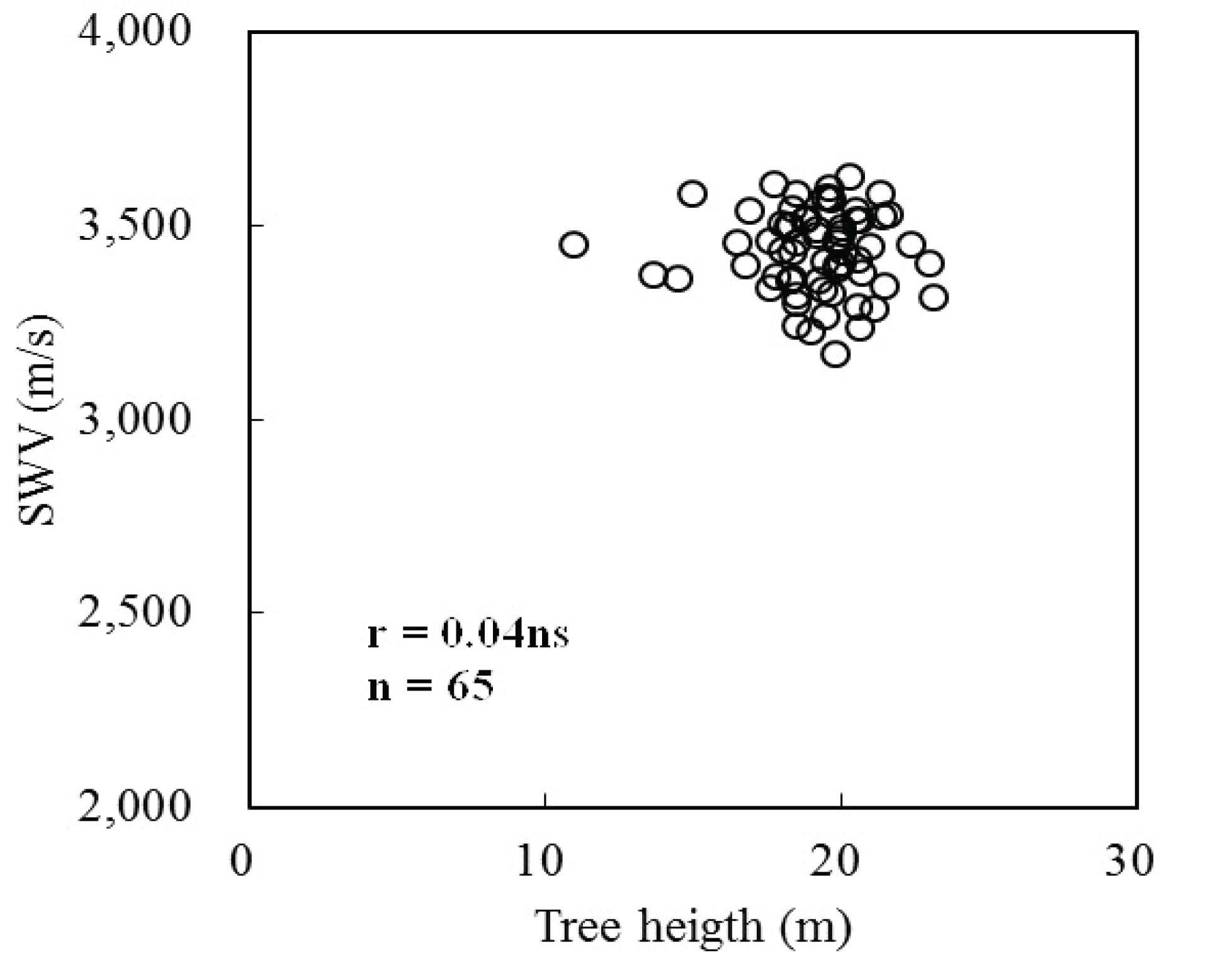
D and SWV showed higher values for heritability, in comparison with H and P (Table 3), therefore, a group of the family was made in accordance with these two characteristics (Fig. 7), where 18 showed high performance (above the mean values), including Family 3, 6, 7, 9, 11, 27, 28, 29, 35, 36, 39, 40, 46, 47, 50, 53, 58, and 61. These could be considered as plus trees for the next generation breeding cycles for improving growth and wood properties of A. mangium.
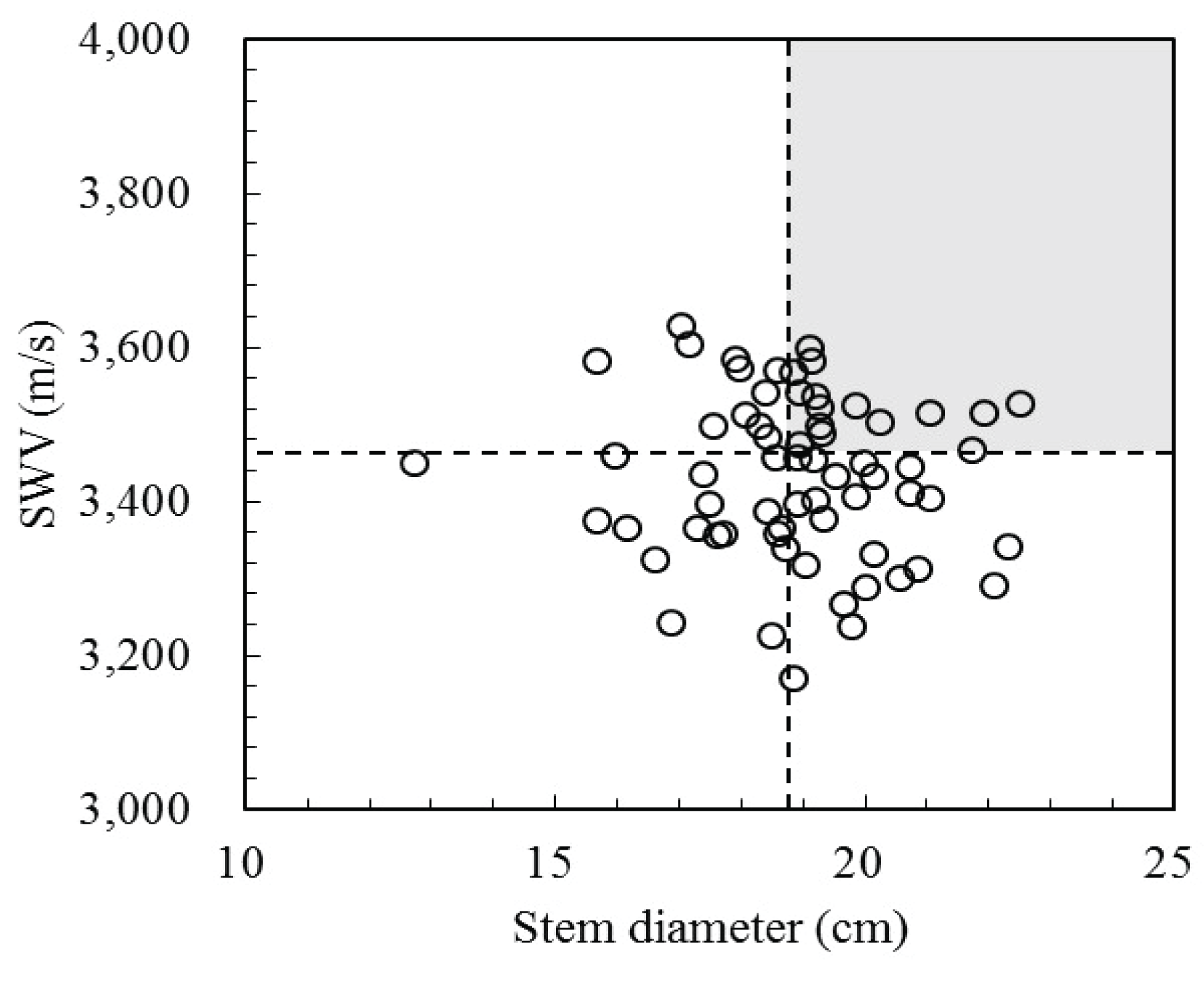
4. CONCLUSION
Characterization of variations in tree growth (D and H) and wood properties (P and SWV) were conducted in third-generation progeny trials of A. mangium in Indonesia, which were observed to vary among families. Furthermore, narrow-sense heritability of these evaluated characteristics was low to moderate, which is suggestive of genetic control. Meanwhile, highly positive correlations were observed between the growth characteristics, but no significant correlations were established with wood properties (P and SWV). Therefore, it is possible to improve breeding programs for A. mangium through the involvement of the analyzed parameters, independently, as the important criteria for selection. In addition, 18 families showed the high performance of D and SWV, suggesting them to be considered as a plus tree for the next generation breeding cycles.








